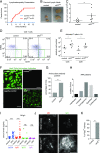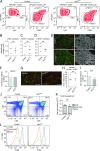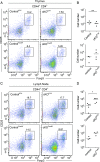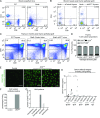Prdm1 Regulates Thymic Epithelial Function To Prevent Autoimmunity
- PMID: 28701508
- PMCID: PMC5544928
- DOI: 10.4049/jimmunol.1600941
Prdm1 Regulates Thymic Epithelial Function To Prevent Autoimmunity
Abstract
Autoimmunity is largely prevented by medullary thymic epithelial cells (TECs) through their expression and presentation of tissue-specific Ags to developing thymocytes, resulting in deletion of self-reactive T cells and supporting regulatory T cell development. The transcription factor Prdm1 has been implicated in autoimmune diseases in humans through genome-wide association studies and in mice using cell type-specific deletion of Prdm1 in T and dendritic cells. In this article, we demonstrate that Prdm1 functions in TECs to prevent autoimmunity in mice. Prdm1 is expressed by a subset of mouse TECs, and conditional deletion of Prdm1 in either Keratin 14- or Foxn1-expressing cells in mice resulted in multisymptom autoimmune pathology. Notably, the development of Foxp3+ regulatory T cells occurs normally in the absence of Blimp1. Importantly, nude mice developed anti-nuclear Abs when transplanted with Prdm1 null TECs, but not wild-type TECs, indicating that Prdm1 functions in TECs to regulate autoantibody production. We show that Prdm1 acts independently of Aire, a crucial transcription factor implicated in medullary TEC function. Collectively, our data highlight a previously unrecognized role for Prdm1 in regulating thymic epithelial function.
Copyright © 2017 The Authors.
Figures





Similar articles
-
Foxa1 and Foxa2 in thymic epithelial cells (TEC) regulate medullary TEC and regulatory T-cell maturation.J Autoimmun. 2018 Sep;93:131-138. doi: 10.1016/j.jaut.2018.07.009. Epub 2018 Jul 27. J Autoimmun. 2018. PMID: 30061015 Free PMC article.
-
Presence of donor-derived thymic epithelial cells in [B6-->MRL/lpr] mice after allogeneic intra-bone marrow-bone marrow transplantation (IBM-BMT).J Autoimmun. 2008 Dec;31(4):408-15. doi: 10.1016/j.jaut.2008.09.003. Epub 2008 Nov 20. J Autoimmun. 2008. PMID: 19022623
-
Formation of a functional thymus initiated by a postnatal epithelial progenitor cell.Nature. 2006 Jun 22;441(7096):992-6. doi: 10.1038/nature04850. Nature. 2006. PMID: 16791198
-
Thymic commitment of regulatory T cells is a pathway of TCR-dependent selection that isolates repertoires undergoing positive or negative selection.Curr Top Microbiol Immunol. 2005;293:43-71. doi: 10.1007/3-540-27702-1_3. Curr Top Microbiol Immunol. 2005. PMID: 15981475 Review.
-
Thymic epithelial cell development and differentiation: cellular and molecular regulation.Protein Cell. 2013 May;4(5):342-55. doi: 10.1007/s13238-013-3014-0. Epub 2013 Apr 15. Protein Cell. 2013. PMID: 23589020 Free PMC article. Review.
Cited by
-
Single-cell and spatial multiomic inference of gene regulatory networks using SCRIPro.Bioinformatics. 2024 Jul 18;40(7):btae466. doi: 10.1093/bioinformatics/btae466. Online ahead of print. Bioinformatics. 2024. PMID: 39024032 Free PMC article.
-
Peripheral T cell activation, not thymic selection, expands the T follicular helper repertoire in a lupus-prone murine model.Proc Natl Acad Sci U S A. 2023 Nov 28;120(48):e2309780120. doi: 10.1073/pnas.2309780120. Epub 2023 Nov 20. Proc Natl Acad Sci U S A. 2023. PMID: 37983487 Free PMC article.
-
Muscle and Muscle-like Autoantigen Expression in Myasthenia Gravis Thymus: Possible Molecular Hint for Autosensitization.Biomedicines. 2023 Feb 28;11(3):732. doi: 10.3390/biomedicines11030732. Biomedicines. 2023. PMID: 36979710 Free PMC article.
-
Aire and Fezf2, two regulators in medullary thymic epithelial cells, control autoimmune diseases by regulating TSAs: Partner or complementer?Front Immunol. 2022 Aug 30;13:948259. doi: 10.3389/fimmu.2022.948259. eCollection 2022. Front Immunol. 2022. PMID: 36110862 Free PMC article. Review.
-
Different Cells of the Human Body: Categories and Morphological Characters.J Microsc Ultrastruct. 2021 Feb 16;10(2):40-46. doi: 10.4103/jmau.jmau_74_20. eCollection 2022 Apr-Jun. J Microsc Ultrastruct. 2021. PMID: 35832316 Free PMC article. Review.
References
-
- Kyewski B., Klein L. 2006. A central role for central tolerance. Annu. Rev. Immunol. 24: 571–606. - PubMed
-
- Derbinski J., Schulte A., Kyewski B., Klein L. 2001. Promiscuous gene expression in medullary thymic epithelial cells mirrors the peripheral self. Nat. Immunol. 2: 1032–1039. - PubMed
-
- Lei Y., Ripen A. M., Ishimaru N., Ohigashi I., Nagasawa T., Jeker L. T., Bösl M. R., Holländer G. A., Hayashi Y., de Waal Malefyt R., et al. 2011. Aire-dependent production of XCL1 mediates medullary accumulation of thymic dendritic cells and contributes to regulatory T cell development. J. Exp. Med. 208: 383–394. - PMC - PubMed
-
- Anderson M. S., Venanzi E. S., Klein L., Chen Z., Berzins S. P., Turley S. J., von Boehmer H., Bronson R., Dierich A., Benoist C., Mathis D. 2002. Projection of an immunological self shadow within the thymus by the aire protein. Science 298: 1395–1401. - PubMed
MeSH terms
Substances
Grants and funding
LinkOut - more resources
Full Text Sources
Other Literature Sources
Molecular Biology Databases

